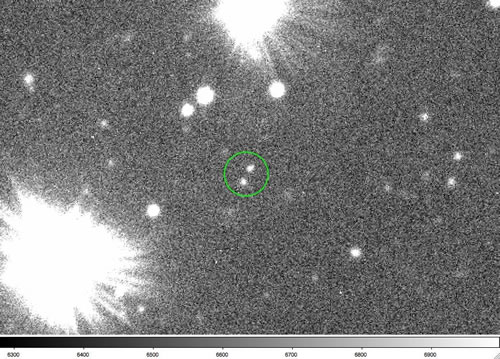[/caption]
Astronomers have discovered a pair of small Kuiper Belt Objects that are gravitationally bound to each other. This is somewhat unusual in itself. But even though these two objects are gravitationally connected, they have an enormous separation between them, about 125,000 kilometers (one third the distance from the Earth to the Moon). Astronomers say, as a comparison, this is equivalent to a pair of baseballs gravitationally “connected” and orbiting each other at a distance of 200 kilometers!
The extreme binary, 2001 QW322, orbits at 43 astronomical units or about 6.5 billion kilometers from the Sun. The pair was originally discovered in August 2001 with the Canada-France-Hawai‘i Telescope. Since then, (from 2002-2007), the pair has been monitored closely using 8-meter-class telescopes (Gemini North, Gemini South and the European Southern Observatory’s Very Large Telescope) to obtain high precision photometric observations of the faint double system.
In the above images, their separation was 1.8 arcseconds. Their radii are about 50 kilometers.
There are on the order of about a billion additional Kuiper Belt Objects in our solar system with Pluto and Charon being among the largest members of this important group of minor planets. These small icy bodies move in low eccentricity and low inclination orbits beyond Neptune, extending possibly as far as 1,000 times the distance from the Earth to the Sun.
Most Kuiper Belt Objects are single objects. The advent of adaptive optics and various survey techniques has created a surge in the discovery of binaries in the main asteroid and Kuiper belts. Astronomers say 2001 QW322 clearly stands out as the widest orbit, near-equal mass binary of the solar system.
Source: Gemini Observatory


NIce to see I’m not the only one who gets ugly, over-saturated images when trying to caputre asteroids and KBOs.
The math doesn’t add up. The objects are 125,000km apart and 50km radii. If you scale the distance to 200km (0.0016 scale factor) and scale the objects by the same amount, the scaled objects’ radii would be 80m. That’s a bit bigger than a baseball.
Impressive photo though. It’s amazing they can take this quality of image from so far away.
This story was on CBC’s Quirks and Quarks a few weeks ago:
Episode website: http://www.cbc.ca/quirks/archives/08-09/qq-2008-10-18.html
Direct link to MP3:
http://www.cbc.ca/quirks/media/2008-2009/mp3/qq-2008-10-18_01.mp3
sUPPOSE THESE OBJECTS WERE MUCH CLOSER
Supposing these objects started out closer to each other; what is the minimum distance/orbit speed that they could have been from each other and still ended up as they are now? Would their rotations have any substantial effect on this process? I ask because it is known that the Moon moves further away from earth in time, and I imagine that perfect orbits (non degrading or expanding ) must be a rarity in the universe.
Do multiple orbiting objects like our solar system keep each others orbits more stable than say, a solar system with one planet?
To me it is like a closer example of Epsilon Lyrae, the famous “Double double”.
These two objects may not orbit each other, but may share common proper motion in space.
I have a real problem with the comparison. I’m no physicist, but simple numbers shows that two baseballs can’t orbit at 200 km and even if the physical attraction changes with the increasing size of the object, common sense says something is wrong here. Someone needs to take their time and not release data in a hurry till they get a better idea of what is going on.
It could be some kind of unforeseen resonant loop caused by the 2 largest concentrations of objects on either side.
@bse5150
I shouldn’t think it’s a hasty release of data – I’d be inclined to call it a typo. It should probably read 200 meters… that’d be about right, I reckon.
Any two objects may remain in such close association as long as there are no other similar objects within a similar distance. When, some time in the future, they do come under the influence of another object, then they will also change their close association.
If they were the only such objects in their region, two golf balls could stay in close association over such a distance. No problem.
If you work it out – given the values here and assuming a baseball is about a 1/12 of a meter across – the seperation is just over 200 meters.
So yes – a typo
Perhaps they are not natural.
Of course they are not natural! I challenge you to find naturally occurring 50km wide giant baseballs. I believe they were made in Haiti.
Apart from the scale misscalculation: they’re 200 m away from each other as David M said. The rest is right and it’s consistent the fact that they’ve been monitoring both objects for such a long time: 5 yrs, obviously slow relative motions for distant bodies.
Both objects could be seen with larger arc separation in the future by its relative motions. But remember this is a 2D image, and they could be aligned in our sight line so that in fact they might be further or closer than 125,000 km
amazing !!!!!!!
i think that is not natural .
I was hoping to find out what they thought these objects are made of.
I am assuming that because they can be so far apart that they have stronger than normal gravity. If that is true would it be easier to narrow down that they are made of something like lead to make them so dense.
Or am I just not understanding gravity and mass?